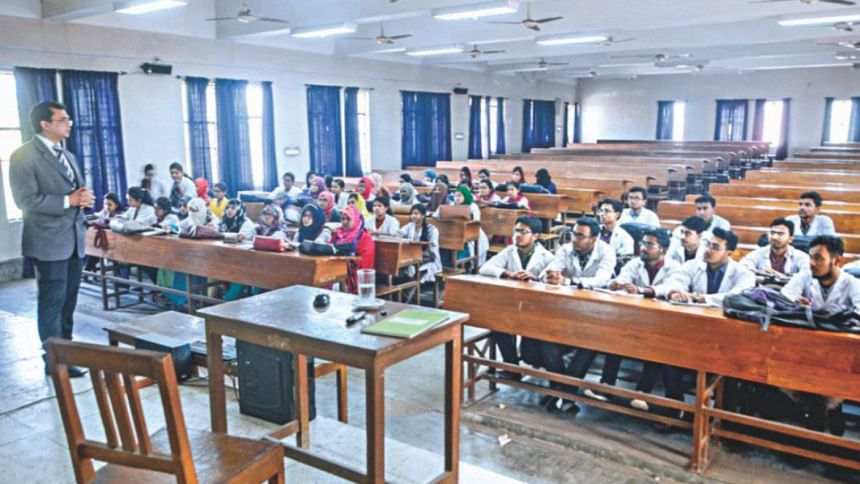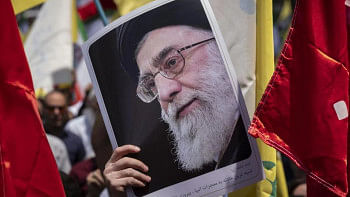Future readiness of Bangladesh's higher education institutions

The Daily Star's February 3rd issue carries a story on page 5 about the acute teacher shortage at Khulna Medical College. It is instructive to take a close look at the accompanying picture. There is a teacher standing on a raised dais; in front of him are rows of benches with 6-8 students occupying one bench. Then there is only one aisle, "if" the teacher ever ventures down from the dais to interact with the students. If the classroom was full, there would likely be 250 students packing the class. In that event, whether students sitting in the back rows would hear the teacher speak, unless he is using a microphone, is a moot question. Whatever muddled message they would pick up on their brain receptors would certainly not translate to much learning from the day's attendance, if at all.
Why do I bring this up? Even if there was no acute shortage of teachers, they would still be teaching in that same classroom layout. And what would they be doing? Lecturing. And why is that a problem? Because today's pedagogy (more correctly, andragogy) stresses learner-centric education, not the age-old teacher-centric approach that ignores student engagement and active learning while continuing to promote rote learning and regurgitation, a phenomenon that is remotely linked to learning.
According to a researcher, "Pedagogy is the process of accompanying learners; caring for and about them; and bringing learning into life." The focus has thus shifted sharply—from teacher to learner. Yet, our educational institutions continue to remain embedded in the past—no innovation, no change, no desire to be future-ready; and the incapacitated students they continue to produce will someday run the affairs of the nation. It must be understood that what and how we teach our children will have far-reaching and future effects on almost every aspect of society.
At a time when the learner-centric rhetoric is rife with terminology such as critical thinking, flipped classrooms, group discussions, problem-solving, simulations, role playing, case analyses, research, and much more, I ask whether these tools can be used in the type of classroom depicted in the picture? Unfortunately, this situation prevails across the nation—classroom after classroom with rows of benches, tight spaces, and little room for meaningful student interaction. Can any learning really occur in this environment?
Research suggests that, "Young people [today] don't want to be passive learners: They are content producers, not just consumers. They communicate in different ways than older generations, in shorter bursts, and they are used to being a part of large networks that allow for instant feedback on their thoughts and ideas." Today's learners dwell in the era of the Fourth Industrial Revolution. Instead of helping this new breed soar, the classrooms of the 21st century in this country are virtually clipping their wings. More importantly, in the digital era, why are our students stuck to benches?
How are we dealing with these issues at the policy level? The Strategic Plan for Higher Education in Bangladesh: 2018-2030 envisages the traits that graduates will display (p. 10); it goes on to say, "Our vision is to see our higher education graduates as critical, conceptual and reflective thinkers 'possessing advanced technical competence… possessing effective communication, management and problem-solving skills; committed to the pursuit of excellence… and are driven by the desire for lifelong learning." This is good, but visions are stratospheric; the reality is far different as the picture portrays.
Surely, changing the classroom layout and environment will not be enough. We also need other fundamental changes, especially in our teachers and teaching. Despite having a segment of great teachers, it is not an exaggeration that many others do not take classes regularly, the classes are not interactive, the traditional lecture method remains firmly ensconced, some teachers do not have a clear idea of either content or materials, course syllabi are horribly out-of-date, learning assessments are questionable, the exams require rote memorisation of mundane/trivial facts and much more. These are fundamental flaws, as is the classroom layout situation, that fail to shape hearts and minds.
An even more fundamental problem is that the most vital sector—education—for an aspiring nation like Bangladesh, climbing the economic ladder, attracts many who never aspired to be teachers; they are there either because they couldn't find more suitable employment or they were looking for something part-time. Is this what our future nation-builders deserve? We also need to assess how the nation's teachers stack up against those who go to other cadres or professions—the pay, the benefits, the facilities, the opportunity for training, the incentives to interact globally, etc. Why would the best and brightest choose teaching as a profession unless they are crazy, deeply passionate, or plain inept?
To fix education, at all levels, several matters require immediate attention: recruitment, training, incentives, funding, accountability, and autonomy of those who run the ship. There is simply no room for politics or intervention here. The supply chain (primary, secondary, and higher secondary education) in particular deserves serious scrutiny if higher education is to serve its purpose. Steeped in rote memorisation and dulled capacity to think imaginatively, students from the lower tiers are just not prepared to meet the challenges at higher levels. Decidedly, a serious mismatch exists between what higher education ought to be and the facts on the ground.
Universities can and must serve as changemakers of changemakers. The desire and will to bring this about must cascade down to the interface where the rubber hits the road. That means the institutions of higher education must shed their benign, indifferent and laid-back attitude. They must also stop thinking of themselves as mere cash cows or avenues for employment. Rather they must take forward the task of imparting education that nurtures the thinkers, the writers, the managers, the inventors, and the problem-solvers. Nations thrive and forge ahead when their educational institutions take on the mantle of changemakers and cultivate the art and science of learning in their bid to prepare future generations.
Professor Syed Saad Andaleeb, Ph.D. is Distinguished Professor Emeritus, Pennsylvania State University, USA and Editor, Journal of Bangladesh Studies.





Comments